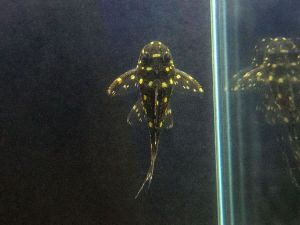
L201 Snowball Pleco (Hypancistrus inspector) also known as the Orinoco Angel Pleco, is a member of the Loricariidae family of South American suckermouth catfishes

The L201 Snowball Pleco (Hypancistrus inspector) is a subspecies of the South American suckermouth catfish known as the Orinoco Angel Pleco. Because of its black body and white spots, this fish stands out in any planted or micro aquarium. We are excited to be one of the first businesses to offer tank-raised juveniles of popular pleco species like the Snowball Pleco at surprisingly low prices.
Snowball Plecos are great for aquariums of any size because they are peaceful and hardy. The adult Snowball pleco only grows to be about 13 to 17 centimeters long (5.5 to 6.3 inches), which is significantly smaller than its close relatives the common pleco (Hypostomus plecostomus) and the Trinidad pleco (Hypostomus punctatus) (8.9 to 10.7 cm). Due to its diminutive size, a 40-gallon aquarium could potentially support a pleco for its entire life, provided it is properly cared for. Although male plecos have a reputation for being territorial, most disputes can be avoided by providing ample space and hiding areas for all fish. In most cases, the Snowball Pleco won't bother with the other fish in the tank, but it might eat the shrimp. However, the Snowball Pleco will not harm giant Amano, Green Lace, Flower, or Vampire Shrimp, and it will leave decorative snails alone as well.
Once the Snowball Pleco is settled into its aquarium, which should contain plenty of driftwood and rockwork, it will typically become active during the day. It is not known to eat as much wood as other plecos (Panaque speciosum, etc.), but occasional supplementation with wood may be beneficial (or bio-film on driftwood). However, the Snowball Pleco is a poor algae eater and therefore poses little threat to garden plants. If you want to keep your Snowball Pleco healthy and happy, feed it a diet high in meat and vegetables, such as vegetable flakes, sinking algae wafers, and pellets. The fresh vegetables shelled peas, spinach, zucchini, and cucumber are all good options. Due to its massive size, this species requires meaty feeds like bloodworms to survive. To thrive, this species needs a fast-moving aquarium's water current.

References
Albino Bushy Nose Pleco (Ancistrus sp.) is a member of the Loricariidae family of South American suckermouth catfishesAsian Stone Mini Catfish (Hara jerdoni) Their small size makes them perfect for small tanks - they only grow to a maximum of 1 1/2 inches in length
Banjo Catfish (Bunocephalus coracoideus) this catfish is popular because of its strange appearance
Bristlenose Pleco (Ancistrus sp.) is a member of the Loricariidae family of South American suckermouth catfishes
Corydoras sterbai (Sterba's Corydoras) are among the most popular of the numerous currently known species within the Corydora classification
L134 Leopard Frog the Imperial Tiger Pleco (Peckoltia compta) is a member of the Loricariidae family of South American suckermouth
L201 Snowball Pleco (Hypancistrus inspector) also known as the Orinoco Angel Pleco, is a member of the Loricariidae family of South American suckermouth catfishes
L333 King Tiger Pleco (Hypancistrus sp.) is primarily nocturnal, but will often become active during daytime hours once established in an aquarium with plenty of driftwood, rockwork
L340 Mega Clown AKA Imperial Tiger Pleco (Hypancistrus sp.)
Otocinclus Catfish known as Otto Cats, otos, or dwarf suckermouth catfish
Panda Cory Catfish (Corydoras panda) is a very animated, distinctively marked schooling fish that is perfect for the community and planted aquarium
Rio Ucayali Bristlenose Pleco is a member of the Loricariidae family of South American suckermouth catfishes. While many suckermouth catfish species have yet to be bred commercially in aquariums, the very rare Orange Spot Bristlenose Pleco is now available




